As summer’s warmth begins to fade and crisp autumn air takes its place, your flower garden doesn’t have to lose its magic. In fact, this transition is one of the most exciting times for gardeners it’s when vibrant late-season blooms, fiery foliage, and cozy autumn accents all come together to create a new chapter of beauty outdoors.
Instead of letting your garden fade as the seasons shift, you can extend its life, introduce fresh colors, and prepare your plants for cooler months ahead. Here’s a comprehensive guide on how to gracefully transition your flower garden from summer to fall.
1. Refresh Your Summer Annuals 🌸➡️🍂
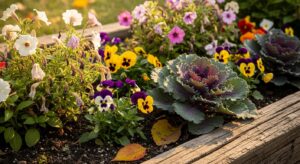
By late August or early September, many summer annuals like petunias, begonias, and impatiens begin to look tired. But you don’t have to clear them all out at once.
-
Deadhead and prune: Remove faded blooms and trim leggy stems to encourage one final flush of flowers.
-
Gradual replacement: As some plants naturally die off, replace them with fall-friendly choices like pansies, violas, or ornamental kale.
-
Mix and match: Blend summer and fall flowers together for a seamless transition period, ensuring your garden never looks “empty.”
Pro Tip: Replace annuals in stages rather than all at once—this keeps your garden colorful during the overlap.
2. Incorporate Fall-Blooming Perennials 🌼🌻
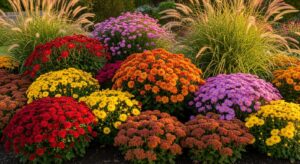
Perennials are the backbone of a garden, and fall-blooming ones provide structure and longevity.
-
Chrysanthemums (Mums): The ultimate fall flower available in yellow, orange, purple, and white.
-
Asters: Perfect for cool-season color with daisy-like blooms.
-
Sedum (Autumn Joy): Adds height and texture with pink-to-burgundy flower clusters.
-
Japanese Anemones: Elegant, pastel blooms that thrive into late fall.
-
Ornamental grasses: Fountain grass, switchgrass, or miscanthus provide texture and movement in autumn breezes.
Pro Tip: Plant perennials in groups of three or five for impact, and mix them with evergreens to keep interest even after frost.
3. Add Seasonal Color with Containers 🪴🍁
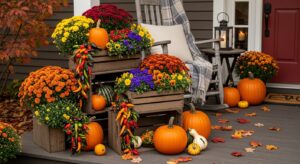
If you’re not ready for a full garden overhaul, containers are a fast and flexible way to introduce fall vibes.
-
Plants to try: Ornamental peppers, chrysanthemums, pansies, dusty miller, violas, and heucheras (coral bells).
-
Design ideas: Mix flowers with pumpkins, gourds, or miniature hay bales for porch displays.
-
Portable beauty: Place containers near entryways, patios, and along garden paths for bursts of color where you need them most.
Pro Tip: Swap out tired summer plants in pots with cold-tolerant varieties to keep displays going until frost.
4. Play with Autumn Color Palettes 🎨🍂

Color sets the mood of your garden, and autumn’s palette is warm, cozy, and dramatic.
-
Classic fall tones: Burnt orange, deep red, golden yellow, and warm brown.
-
Complementary contrasts: Pair bright marigolds with dark purple cabbage, or golden rudbeckia with ornamental kale.
-
Foliage matters too: Plants like coleus, coral bells, and purple fountain grass add rich tones without relying solely on flowers.
Pro Tip: Use seasonal accessories (lanterns, rustic baskets, or wooden crates) in your color scheme to tie everything together.
5. Layer Your Plantings for Depth 🌿➡️🍂
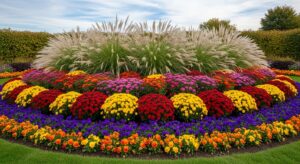
Fall is the perfect time to create structured, layered garden beds that look lush even as flowers fade.
-
Back layer: Taller plants like ornamental grasses, sunflowers, or tall sedums.
-
Middle layer: Perennials like chrysanthemums, asters, and Japanese anemones.
-
Front layer: Low-growing pansies, violas, creeping thyme, or groundcover sedum.
Pro Tip: This layered look not only creates depth but also ensures that as one plant fades, another takes the spotlight.
6. Introduce Seasonal Decor 🎃🌾
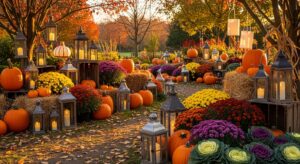
Autumn gardens shine brightest when paired with cozy seasonal accents.
-
Rustic additions: Hay bales, corn stalks, and wooden crates.
-
Natural touches: Pumpkins, gourds, and dried sunflower heads as garden displays.
-
Lighting: Add lanterns, string lights, or fairy lights for a magical glow on cooler evenings.
Pro Tip: Use natural elements like gourds or dried seed pods that can be composted afterward—eco-friendly and beautiful.
7. Prepare for Cooler Weather ❄️🍂

A fall transition isn’t just about looks it’s also about preparing your garden for survival and success.
-
Mulch perennials: Add a fresh layer of mulch to protect roots from frost.
-
Cut back wisely: Trim dead stems, but leave seed heads (like echinacea or black-eyed Susans) for birds and winter interest.
-
Plant bulbs now: Tulips, daffodils, and hyacinths planted in fall will reward you with early spring blooms.
-
Collect seeds: Save seeds from summer favorites to replant next year.
Pro Tip: Start a fall compost pile with fallen leaves and spent plants to enrich your soil for spring.
🌼 FAQs – From Summer to Fall: Transitioning Your Flower Garden 🍁
1. When should I start transitioning my flower garden from summer to fall? 📅🌸🍂
The best time is late August through September, when summer flowers begin to fade but before the first frost. This ensures a smooth seasonal shift.
2. Do I need to remove all my summer flowers at once? 🌼✂️
No! Start by deadheading and trimming back tired blooms. Replace plants gradually with fall flowers so your garden never looks bare.
3. What are the best flowers for fall gardens? 🌻🍁
Top picks include chrysanthemums, asters, sedum, Japanese anemones, pansies, violas, and ornamental kale. These thrive in cooler weather and add rich autumn color.
4. Can I mix summer and fall flowers together? 🌸➕🌼
Absolutely! Combining them creates a seamless transition. For example, pair fading petunias with freshly planted mums or pansies for layered color.
5. How can I keep my garden colorful in the fall? 🎨🍂
Choose warm tones like orange marigolds, golden rudbeckia, and red chrysanthemums. Add contrasting foliage such as purple kale or coral bells for depth.
6. What’s a simple way to add fall charm without replanting everything? 🪴🎃
Use containers and decor! Fill pots with mums, violas, and ornamental peppers, and decorate with pumpkins, gourds, or lanterns for instant seasonal flair.
7. How do I prepare my flower garden for the first frost? ❄️🌱
Mulch around perennials, cut back spent annuals, and cover tender plants with frost cloths. This helps protect roots and extends bloom time.
8. Should I plant bulbs in the fall? 🌷📦🍁
Yes! Fall is the ideal time to plant spring-blooming bulbs like tulips, daffodils, and hyacinths. They’ll rest over winter and burst into color in spring.
9. How can I make my fall garden more eco-friendly? ♻️🌿
Compost fallen leaves, save seeds, and use natural decor like pumpkins and dried seed pods that can return to the soil after the season.
10. What’s the biggest mistake gardeners make when transitioning seasons? 🚫🌸🍂
The most common mistake is pulling out summer plants too early or ignoring garden prep for winter. Balance beauty with practicality by refreshing blooms while also protecting perennials.
🌸 Final Thoughts: Embrace the Season of Change 🍁
Transitioning your flower garden from summer to fall isn’t about ending it’s about transforming. By refreshing annuals, adding late-season perennials, layering beds, and embracing seasonal colors and decor, you can create a garden that thrives well into autumn.
The shift from bright summer days to crisp autumn evenings offers a chance to celebrate the beauty of change and your garden can be the perfect reflection of that.
So grab your gloves, gather your fall favorites, and let your garden gracefully bloom into the new season. 🌼🍂🌻